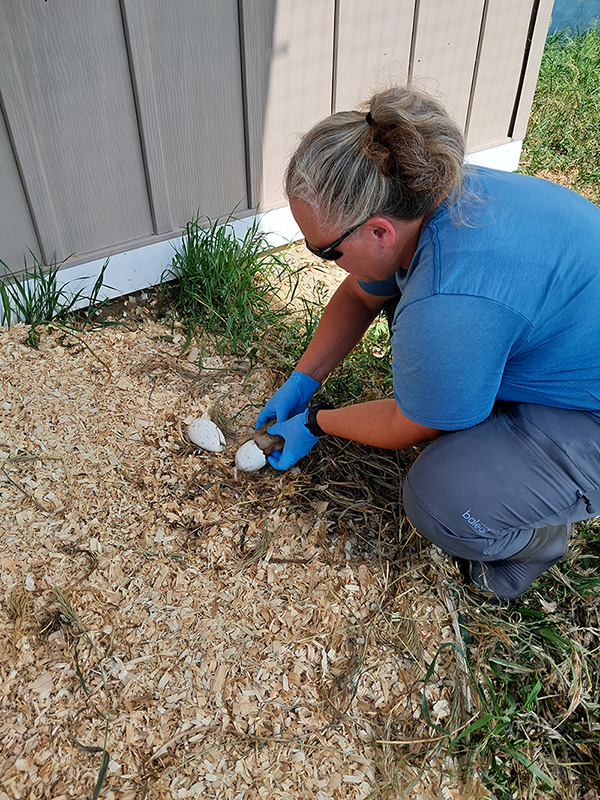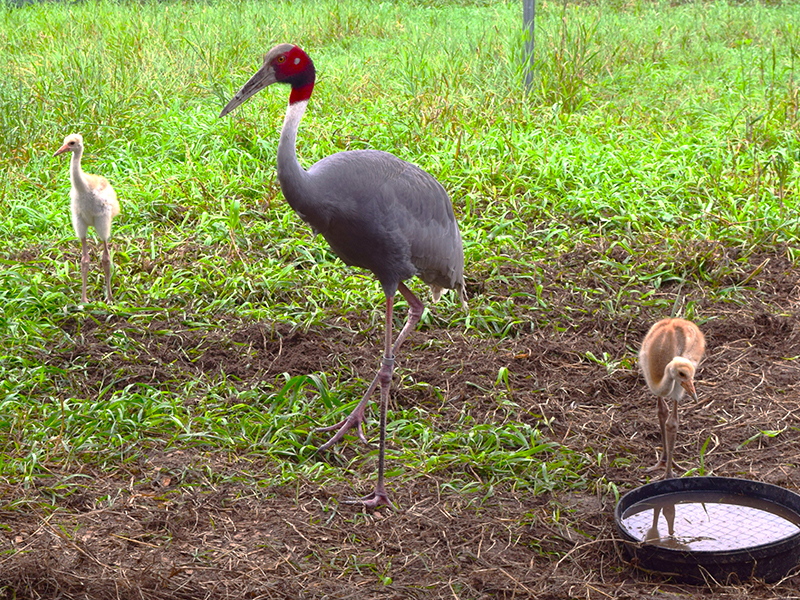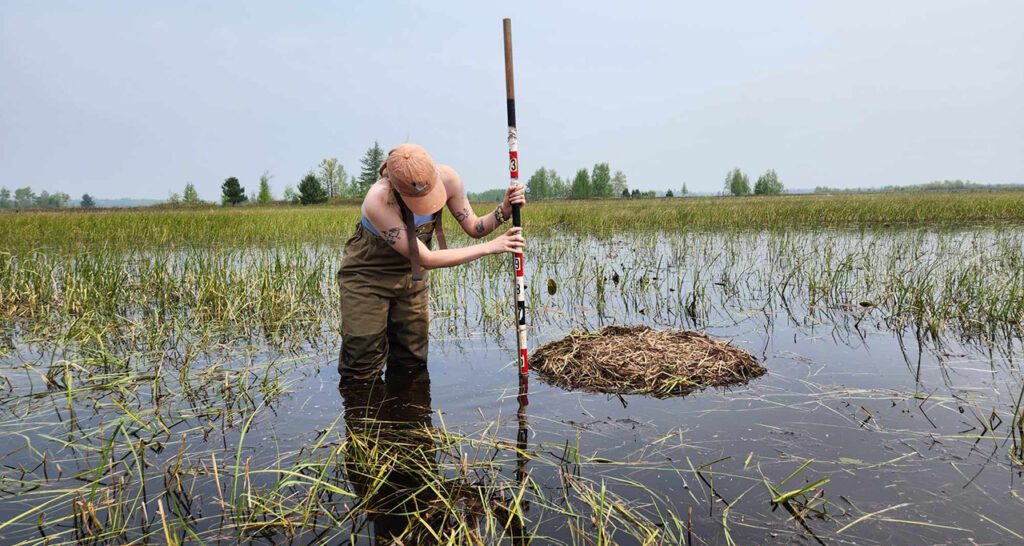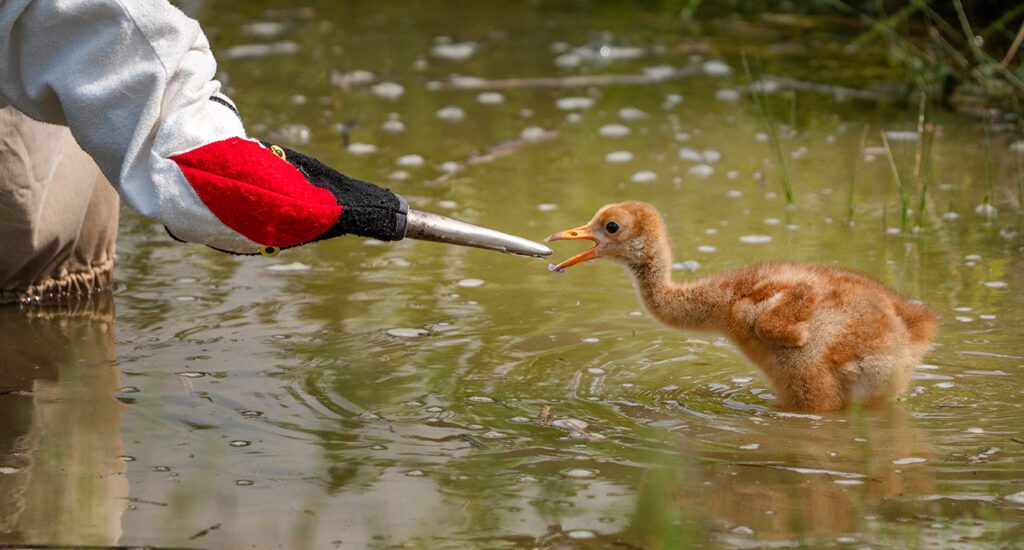Doubling our Conservation Efforts with Sarus Crane Twins

Our Director of Conservation Medicine Dr. Diana Boon conducts a health exam on one of this year’s Sarus Crane chicks. The tape on the chick’s toe helps ensure the toe grows straight during its rapid development. Ryan Michalesko/International Crane Foundation
It’s been over 10 years since the International Crane Foundation’s Crane Conservation Department successfully bred a Sarus Crane. Many long-time Foundation members might remember our previous resident pair of Sarus Cranes, Chandini and Majnu, who raised a chick on exhibit in 2014. Since then, our staff has been quietly working to strengthen our capacity to focus on conservation efforts for this species both in North America and around the world.

Sarus Crane female Chandini with chick Curry in 2014 at our headquarters. In 2017, Curry was relocated to the Los Angeles Zoo. Ted Thousand
Over the past five years, our aviculture staff has been working to strategically increase the number of Sarus Cranes in our residential flock at our global headquarters, aiming to meet our specific collection goals for this species. We acquired an established pair, Yuva and Minu, to serve as our Sarus Crane ambassadors on exhibit at the Crane Discovery Center. An additional male Sarus Crane, Terai, was transferred to the International Crane Foundation in 2022 upon the recommendation of the Association of Zoos and Aquariums (AZA) Species Survival Program (SSP/Studbook) coordinator, to be paired and bred with our long-time resident female, Chandini.
This year, we decided to include Sarus Cranes, specifically Chandini and Terai, in our breeding plans and took advantage of every opportunity with this pair. Our evaluations over the past two years had already shown that if we were to breed this pair, we would need to use assisted reproductive techniques to produce fertile eggs. The next steps were to assess Terai’s response to our artificial insemination methods and evaluate his semen samples. Terai’s semen appeared to be of good quality, but the final test was to inseminate the female and see if she laid fertile eggs. She laid two fertile eggs!

After hatching in an on-site incubator, Assistant Curator of Birds Cynthia Gitter places Dino in Chandini and Terai’s nest. A second artificial egg is in the nest and will soon be replaced by Reptar after their hatch. Kim Boardman/International Crane Foundation
Now we faced a decision—what to do with two fertile eggs? When developing a chick-rearing plan for a new pair of cranes with limited parental experience, such as Chandini and Terai, we typically have them raise a single chick to increase the chances of survival. Typically, we also consider transferring any extra fertile eggs to other AZA zoological facilities to be raised by different cranes. However, this year, we didn’t have good options for transferring our second Sarus Crane egg, so we considered the idea of “twinning”—having Chandini and Terai raise both of their chicks. The last time we used the “twinning” technique in chick-rearing was in the late 1980s. Although it isn’t a common method for us, we saw value in trying it with our Sarus Cranes.

Chandini and the two chicks in their off-exhibit enclosure at our headquarters. Jessica Colvin/International Crane Foundation
The AZA Species Survival Programs focus on cooperative conservation efforts to maintain healthy, genetically diverse, and demographically stable populations of selected animal species for the long-term future. These SSP populations could be used for species reintroduction efforts if needed. The Sarus Crane SSP has struggled with decreased interest in this species among zoos, insufficient space for the species, and limited breeding efforts. For these reasons, the Sarus Crane SSP was dissolved as a formal program a few years ago, which means individual zoological institutions must remain interested and committed to conserving the species despite the absence of a formally managed program.
Additionally, the International Crane Foundation’s Asia program staff have been helping to reintroduce Sarus Cranes to Tram Chim National Park in Vietnam. Senior Crane Conservation and Conservation Medicine staff have offered advice on crane care, breeding, rearing, and reintroduction methods to support these efforts. By expanding our knowledge of breeding Sarus Cranes and chick-rearing techniques, such as “twinning,” we aim to enthusiastically share that knowledge with our international colleagues and partners. Learn more about this new reintroduction project here.
Our Southeast Asia Program Director Dr. Tran Triet and Curator of Birds Kim Boardman tour the Sarus Crane reintroduction facilities at Tram Chim National Park in Vietnam in 2024. Video by Diana Boon/International Crane Foundation
Knowing we’d learn a lot from the experience, feeling optimistic about our birds’ parental instincts, and committed to conserving the species, our team pressed on with efforts to have our new Sarus Crane pair raise two chicks. Although our two fertile eggs faced some challenges during incubation and hatching that they had to overcome, with a little help from our staff, Dino and Reptar made a dinosaur-sized entrance into this world!
Hatched on June 23 (Dino) and June 26 (Reptar), the Sarus twins are now about three weeks old. Both parents have kept them safe and warm, tilled the yard in search of insects to feed them, and both chicks are thriving! We are learning from them every day and look forward to watching the family grow and do their part for Sarus Cranes!

Story submitted by Cynthia Gitter, Assistant Curator of Birds. Learn more about our Global Headquarters programs here.
June 22, 2025


